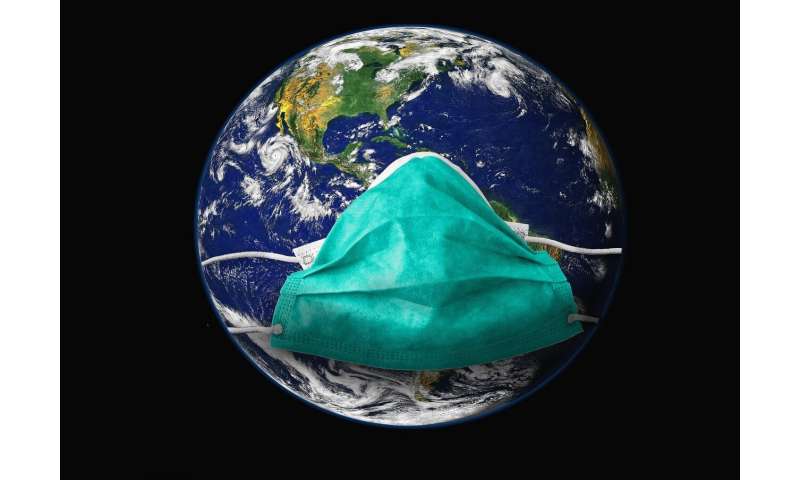Are you wearing your face mask properly? Many people aren’t, coronavirus experts say


You’ve probably seen them at the supermarket or on the streets: People wearing surgical face masks pulled down under their noses, touching their face masks or dropping used face masks in public trash cans.
There’s a right way and plenty of wrong ways to use face masks to help fight the spread of coronavirus, experts say. And a lot of people are on the wrong track.
On Friday, the U.S. Centers for Disease Control and Prevention recommended that people wear homemade cloth face masks in public, reversing its earlier advice, McClatchy News previously reported.
While some communities have mandated face masks in public, the CDC’s suggestion is considered voluntary, the Los Angeles Times reported. President Donald Trump, for example, has said he doesn’t expect to wear one.
On the other hand, mayors and governors across the United States, including Colorado Gov. Jared Polis, are wearing homemade face masks in public to set a good example, The New York Times reports.
The government’s changing advice on masks could be “confusing to the American people,” conceded U.S. Surgeon General Jerome Adams, according to the publication.
It’s partly because surgical masks, whether store-bought or homemade, don’t protect the wearer against the COVID-19 virus, the CDC says. But face masks can help prevent infected people from spreading the virus, even if they have no symptoms—prompting the change.
“So it’s not going to protect you, but it is going to protect your neighbor,” said infectious disease specialist Dr. Daniel Griffin at Columbia University, NPR reported.
There’s a catch, however. You have to wear the mask correctly and dispose of it properly, or you might actually increase the infection risk to yourself or others.
“That’s what I see all the time,” Griffin said, NPR reported. “That’s why in the studies, masks fail—people don’t use them (correctly). They touch the front of it. They adjust it. They push it down somehow to get their nose stuck out.”
More than 1.2 million cases of the COVID-19 virus have been confirmed worldwide with more than 68,000 deaths as of April 5, according to Johns Hopkins University. The United States has more than 331,000 confirmed cases with more than 9,100 deaths.
The World Health Organization has declared coronavirus a global pandemic. The United States has declared a national emergency.
Here’s what you need to know about properly using face masks.
Q. Who shouldn’t wear face masks?
A. The CDC says cloth face masks aren’t for children under age 2, people with breathing problems, and unconscious or incapacitated people who can’t take one off without help.
Q. What makes a good cloth face mask?
A. Cloth face masks should have multiple layers of fabric fit comfortably but snugly, have ear ties or loops, and not lose their shape after being washed, the CDC says. They should allow you to breathe without restriction.
Patterns and guides for creating your own sewn or non-sew face masks are available online.
Disposable or store-bought surgical masks and N95 respirators should be reserved for hospital and medical personnel, CNBC says.
Q. How do I properly put on a face mask?
A. Wash your hands first with soap and water, says the World Health Organization. Get used to this piece of advice—you’re going to read it a lot.
Inspect the mask for tears or holes, and throw it out if it’s damaged, Healthline advises. The metal strip in disposable masks goes on top.
Cover your mouth and nose with the mask, ensuring it fits snugly with no gaps between your face and the mask, WHO advises.
Use ties or ear loops to secure the mask, the CDC says.
Q. What are some tips for properly wearing a face mask?
A. Keep the mask on until you’re back at home or it’s time to switch to a fresh mask, CNBC says. And don’t touch the mask or your face.
Don’t pull the mask down to eat a snack, then pull it back up, NPR says. You’ll put whatever’s on the mask into your mouth.
And don’t get overconfident, CNBC reported. Remember, the mask won’t protect you—it might help protect those around you.
“Better to keep the six-foot distance, better to keep in homes, better to keep washing your hands,” said Peter Gulick, associate professor of medicine at Michigan State University, according to the network.
“To be clear, you should still stay at home. This isn’t an excuse to suddenly all go out,” said Mayor Eric Garcetti of Los Angeles, the Los Angeles Times reported.
Q. How do I properly take a face mask off?
A. Don’t touch the front of the mask, WHO advises. Instead, take the mask off by untying or pulling off the straps around your ears. Keep it away from your face.
And be sure not to touch your eyes, nose or mouth while taking off the mask, says the CDC.
Then wash your hands with soap and water, WHO says.
Q. How often should I change face masks?
A. Change your face mask as soon as it becomes damp, and don’t reuse disposable masks, WHO says.
Q. Do I need to wash a cloth face mask?
A. Wash reusable face masks every time you use one, the CDC says. A washing machine should do the job of sterilizing the masks.
“You don’t take this dirty mask off, put it in your purse and then stick it back on your face,” said Griffin, NPR reported.
“It’s something that once you put on, is potentially either touching your coughs, sneezes or the spray of your speech, or protecting you from the coughs, spray, speech of other people,” he said, according to the network. “And now it’s dirty. It needs to basically be either discarded or washed.”
Q. How do I dispose of used face masks?
Source: Read Full Article